dam
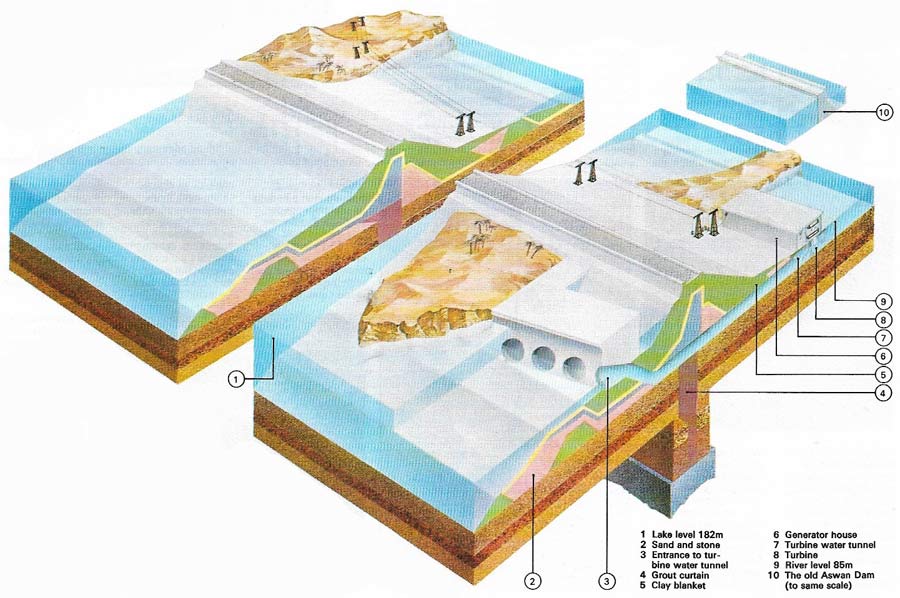
Fig 1. The Aswan High Dam in Egypt is a typical rockfill or embankment dam. Completed in 1970, the 110 m (360 ft) high dam was constructed with technical and economic aid from Russia. Lake Nasser, created by the dam, is 500 km (310 miles) long and contains 164 billion cubic meters of water for irrigation, fishing, and hydroelectric power. The released water drives 12 hydroelectric turbines, producing 10 billion megawatts of electricity annually, enough for domestic consumption and export. Unfortunately many harmful side-effects of the project have become evident. For example, the dam retains the Nile silt, depriving the farmers in upper Egypt of fertile deposits and accelerating erosion at the coast.
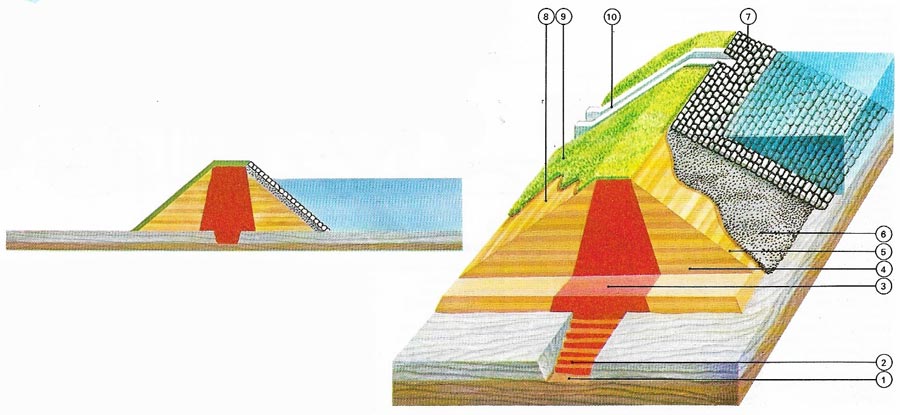
Fig 2. An earthfill dam is begun by digging a trench until impervious rock is reached. This is excavated and the first layer of impervious core material (probably clay) is grouted into this trench (1). Successive layers (2) of clay are added and rolled until they are completely compact. Once this foundation is ready only the core is formed from impervious material (3). The rest of the dam is constructed with layers of any soil (4). The upstream slope (5) is covered with gravel (6) and surfaced with rocks called rip-rap (7) to prevent water erosion. The downstream slope (8) is sown with vegetation (9) for stability. A spillway (10) is usually built into the slope to allow water to flow over the dam in times of flooding.

Fig 3. Hoover Dam.
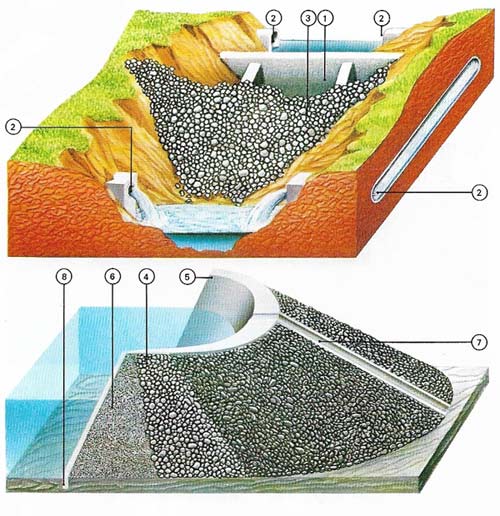
Fig 4. A river must be diverted before it can be dammed. A temporary coffer dam (1) is built and the water diverted via tunnels (2). The permanent dam is then constructed behind the coffer dam. The rock core (3) of this gravity dam is first laid and compacted. Rubble (4) and an impervious facing (5) are added to the steep, concave upstream slope (6) and the spillway (7) to the downstream side. It is now vital that no subsequent settlement occurs. The impervious facing is grouted into the bedrock (8) to prevent seepage under the dam. The coffer dam is usually incorporated into the structure of the finished permanent dam.
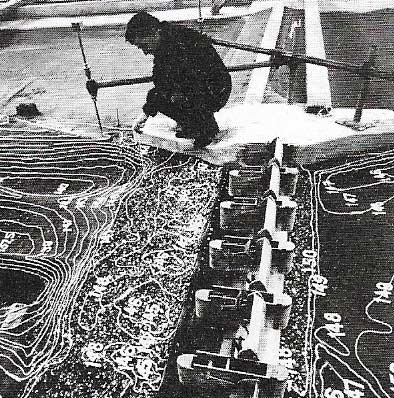
Fig 5. Laboratory testing of hydraulic models often precedes the start of work on the actual dam. These models give advance data on patterns of erosion which the water flow may cause. By this means the engineer who design a river barrage or the outflow channels of a hydroelectric scheme can avoid the problems of water scour.
A dam is a structure for impeding and controlling the flow of water in a water course, and which increases the water elevation to create the hydraulic head. The reservoir creates, in effect, stored energy.
Dams are one of the earliest known man-made structures, records existing from around 2900 BC of a 15-meter-high dam on the Nile. Construction methods were largely empirical until 1866, when the first scientifically designed dam was built in France.
Dams are classified by profile and building materials, these being determined by availability and site. They must be strong enough to hold back water; withstand ice, silt, and uplift pressures, and stresses from temperature changes and earthquakes. The site must have stable earth or rock that will not unduly compress, squeeze out or let water seep under the dam. Borings, seismic tests, structural models, and computer simulations are all design aids.
Masonry or concrete dams are typically used for blocking streams in narrow gorges. The highest are around 300 meters high. A gravity dam holds back water by its own weight and may be solid, sloping downstream with a thick base, or buttressed, sloping upstream and strengthened by buttresses which transfer the dead weight sideways; these require less concrete. Arch dams, with one or more arches pointing upstream, are often built across a canyon and transfer some water pressure to its walls. The Hoover Dam (Fig 3), built in 1936, is a combination of arch and gravity types. Embankment or earthfill dams are large barriers of rock, sand, silt, or clay for controlling broad streams. As in a gravity dam, their weight deflects the horizontal water thrust downward toward the broad base. The materials may be uniformly mixed or there may be zones of waterproof material such as concrete either on the upstream face or inside the dam. During construction, temporary cofferdams are built to keep water away from the site. Automatic spillways for excess water, intakes, gates, and bypasses for fish and ships all form part of a dam complex.
History of dams
Control of a life-sustaining water supply has always been one of man's primary concerns. For 5,000 years, dams have been instrumental in this control, being used to avert floods, divert rivers, store water, and irrigate land. Many of today's constructions fulfil these same age-old functions; dams are still used for agricultural irrigation and domestic water storage and supply, as well as for the more sophisticated purposes of hydroelectric power generation, land reclamation, control of erosion by floods, and the prevention of build-up of silt.
The use of barriers to divert part of a river's flow into irrigation canals was developed by British engineers during the nineteenth century, and used widely in the Punjab of northern India. French engineers built a similar barrage across the River Nile, which allowed the summer flood to pass over it but formed a reservoir from which the water was led, during the spring and early summer, into irrigation canals. In this way, huge areas of previously parched land were made productive.
The development of modern engineering materials and techniques have since made it possible not only to divert part of a river's water, but also to hold and store water by the creation of huge lakes behind a solid dam wall. A typical early example is the Hoover Dam, built across the Colorado River in the United States. Completed in 1936, this dam has a reservoir capacity of 38,000 million cubic meters (49,000 million cubic yards) and a power output, from the water released through its turbines, of 1,340 megawatts.
Dam design
There are two main types of modern dams: embankment dams, built from earth and rockfill, and concrete dams (which may or may not be reinforced). Embankment dams came first and today are generally the cheapest to build because they need fewer workers. They include the world's tallest dams, such as the 310 m (1,017 ft) Nurek Dam in Russia, and the 234 m (770 ft) Oroville Dam in the United States. They are built from the natural earth and rock found near the site, consisting essentially of a central earth core to hold back the water, faced and supported on each side with more earth or rock. "Filter curtains" between the various layers prevent fine grains from one being washed into the voids of the next.
Embankment dams are suitable for nearly all sites because they can withstand some settlement of the foundation and do not need strong valley sides. A deep trench filled with compacted clay or concrete forms a curtain to prevent water from seeping under the dam. A line of wells under the toe of the dam collects any seepage water and leads it back to the course of the river.
The greater strength of rockfill allows it to be used with steeper slopes. One of the cheapest types of dam has rockfill with a waterproof skin of bitumen concrete on the reservoir side.
There are a number of designs for concrete dams. The simplest, the gravity dam, works rather like a bookend, its own weight preventing it from being turned over by the force of the reservoir water. Volume of material is reduced by a buttress construction.
An arch dam, a more sophisticated construction, is like an arch bridge lying on its side. The curve of the arch is designed so that the concrete (weak in tension) is held permanently in compression. For success, this type of dam has to be firmly keyed into the rock of the valley sides at its ends.
The thinnest type of dam, also with its concrete kept in compression, is the double-curved cupola dam. It is shaped rather like half an egg, with the bulge facing into the pressure of the reservoir water.
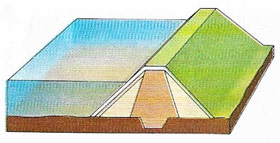 |
| The design of a modern dam depends partly on its situation and partly on local availability of materials and labor. The engineer's choice must be carefully calculated to produce the most economical, practical solution. A solid gravity dam resists water pressure by sheer weight. It is usually made of mass concrete. |
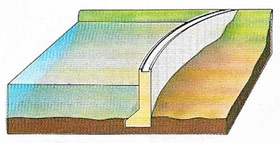 |
| The arch dam acts like an arch bridge laid on its side, the load being transferred to its ends. |
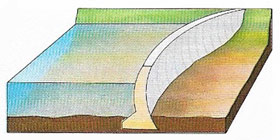 |
| The cupola (double curvature) dam is convex in shape. This eggshell shape gives added strength. |
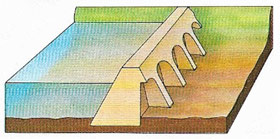 |
| Long straight dams are generally built with buttresses for strength. |
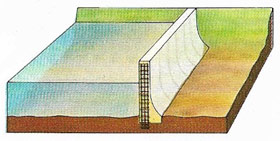 |
| A prestressed vertical cantilever is built by setting tensioned steel cables in the wall. |
Dam foundations
Engineers generally fill fissures in the rock foundation of a concrete dam with a curtain of grout. A drainage system leads away any seepage water, to prevent a build-up of pressure under the dam. There is often a row of drainage wells, drilled into the rock from a gallery running the length of the dam.
To construct the foundation of a dam while water is flowing, engineers generally drive a diversion tunnel through the rock of the valley wall around the dam site, before the construction work starts on the dam itself (Fig 4). A temporary dam is then constructed to divert the water into the tunnel and the main dam constructed on the dry downstream side of the temporary one.
Every dam construction must allow excess water to flow away in times of flood, without causing erosion in the process. The excess is usually dispersed in one of three ways: by a concrete-lined spillway at a level lower than the top of the dam; by an overflow shaft – usually funnel-mouthed – leading vertically down from a point well within the reservoir; or by an 'overflow channel or tunnel leading from a point at the side of the reservoir to below the dam.
Great modern dams
The world's greatest dams (in terms of reservoir capacity) are: Owen Falls, Uganda, built across the Victoria Nile in 1954 and holding a reservoir of 205,000 million cubic metres behind a gravity dam; Bratsk Dam, Russia, built across the River Angara in 1964 (169,000 million cubic meters), a concrete gravity dam; and Aswan High Dam (Fig 1), Egypt, built across the River Nile and completed in 1970 (164,000 million cubic meters), a rockfill embankment.
